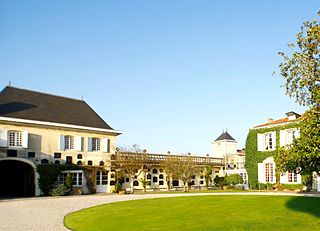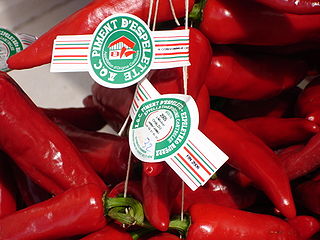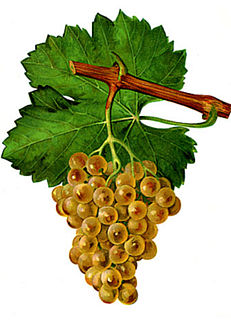
Château d'Yquem is a Premier Cru Supérieur wine from the Sauternes, Gironde region in the southern part of the Bordeaux vineyards known as Graves. In the Bordeaux Wine Official Classification of 1855, Château d'Yquem was the only Sauternes given this rating, indicating its perceived superiority and higher prices over all other wines of its type. Yquem's success stems largely from the site's susceptibility to attack by "noble rot".

Château Prieuré-Lichine, previously Château Le Prieuré and Château Prieuré-Cantenac, is a winery in the Margaux appellation of the Bordeaux region of France, in the commune of Cantenac. The wine produced here was classified as one of ten Quatrièmes Crus in the historic Bordeaux Wine Official Classification of 1855.
Château Brane-Cantenac is a winery in the Margaux appellation of the Bordeaux wine region of France. The wine produced here was classified as one of fifteen Deuxièmes Crus in the original Bordeaux Wine Official Classification of 1855.

Château Coutet is a Premier Cru Classé sweet wine from the Sauternes-Barsac appellation located in Barsac, in the southern part of France’s Bordeaux vineyards. Château Coutet is one of the oldest Sauternes producing vineyards, and is described by David Peppercorn as a "twin" of Barsac's other Premier cru estate, Château Climens.

Château Climens is a Premier Cru Classé Sauternes wine producer from the Barsac appellation. The estate is located in the southern part of France’s Bordeaux wine region in the district of Graves, an eighth of a mile away from Barsac's other most historically rated vineyard, Château Coutet.

Château Filhot, archaically named Maison Noble de Verdoulet, is a winery rated Deuxième cru classé in the Bordeaux Wine Official Classification of 1855, from the Sauternes appellation in Gironde. Considered by some unjustly omitted from the Premier cru classification, Filhot produces a drier wine than Château d'Yquem, with an unusually high alcohol content for a Sauternes.

Château Lafaurie-Peyraguey is a Premier Cru Classé Sauternes wine from the Sauternes appellation. The winery is located in the southern part of France’s Bordeaux wine region in the district of Graves in the commune of Bommes, and its château is situated on a hill top facing Sauternes' highest classed vineyard, Château d'Yquem.
Château La Tour Blanche, or La Tour-Blanche, is a sweet white wine ranked as Premier Cru Classé in the original Bordeaux Wine Official Classification of 1855. Belonging to the Sauternes appellation in Gironde, in the region of Graves, the winery is located in the commune of Bommes.
Château de Rayne-Vigneau is a sweet white wine ranked as Premier Cru Classé in the original Bordeaux Wine Official Classification of 1855. Belonging to the Sauternes appellation in Gironde, in the region of Graves, the winery is located in Bommes. It has been owned by Crédit Agricole since 2004.
Château Suduiraut, formerly Cru du Roy and Château de Suduiraut, is a sweet white wine ranked as Premier Cru Classé in the original Bordeaux Wine Official Classification of 1855. Belonging to the Sauternes appellation in Gironde, in the region of Graves, the winery is located in Preignac, adjacent to Château d'Yquem.
Château Guiraud is a sweet white wine ranked as Premier Cru Classé in the original Bordeaux Wine Official Classification of 1855. Belonging to the Sauternes appellation in Gironde, in the region of Graves, the winery is located in the commune of Sauternes. The estate vine plantings consist of 65% Semillon and 35% Sauvignon Blanc. The vines are on average 35–40 years old.
Château Rieussec is a sweet white wine ranked as Premier Cru Classé in the original Bordeaux Wine Official Classification of 1855. Belonging to the Sauternes appellation in Gironde, in the region of Graves, the winery is located in the commune of Fargues.

Château Rabaud-Promis is a Bordeaux wine producer in the Sauternes appellation. Its sweet white wine ranked as Premier Cru Classé in the original Bordeaux Wine Official Classification of 1855. It is located in the commune of Bommes in the region of Graves. It was once joined with Château Sigalas-Rabaud in the estate named Château Rabaud.

Château Sigalas-Rabaud, previously also named Château Rabaud-Sigalas, is a Bordeaux wine producer in the Sauternes appellation. Its sweet white wine ranked as Premier Cru Classé in the original Bordeaux Wine Official Classification of 1855. It is located in the commune of Bommes in the region of Graves. It was once joined with Château Rabaud-Promis in the estate named Château Rabaud. With only 14 hectares, Château Sigalas-Rabaud is the smallest of all crus classés of the 1855 classification.
Château de Myrat or simply Château Myrat, is a wine estate belonging to the Sauternes appellation in Gironde, in the region of Graves. The estate is located in the commune of Barsac and produces a sweet white wine (Sauternes) ranked as a Grand Cru of Second Growth class in the original Bordeaux Wine Official Classification of 1855.
Château Doisy Daëne is Bordeaux wine producer located in the commune of Barsac. Its sweet white wine ranked as Second Cru Classé in the original Bordeaux Wine Official Classification of 1855. It belongs to the Sauternes appellation in Gironde, in the region of Graves.
Château d'Arche is a sweet white wine ranked as Second Cru Classé in the original Bordeaux Wine Official Classification of 1855. Belonging to the Sauternes appellation in Gironde, in the region of Graves, the winery is located in the commune of Sauternes.

Château de Malle is a sweet white wine ranked as Second Cru Classé in the original Bordeaux Wine Official Classification of 1855. Belonging to the Sauternes appellation in Gironde, in the region of Graves, the winery is located in the commune of Sauternes. The gardens of the chateau are classified among the Notable Gardens of France by the Committee of Parks and Gardens of the French Ministry of Culture.
















